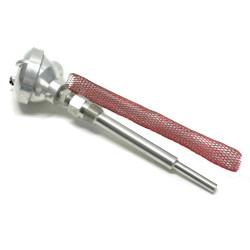
The electrical resistance of metals rises as heat increases and the metals become hotter, while their electrical resistance falls as heat decreases and the metals become colder. RTDs are temperature sensors that use the changes in the electrical resistance of metals to measure the changes in the local temperature. For the readings to be interpretable, the metals used in RTDs must have electrical resistances known to people and recorded for convenient reference. As a result, copper, nickel, and platinum are all popular metals used in the construction of RTDs.
Thermocouples are temperature sensors that use two different metals in the sensor to produce a voltage that can be read to determine the local temperature. Different combinations of metals can be used in building the thermocouples to provide different calibrations with different temperature ranges and sensor characteristics.
Because the terms encompass entire ranges of temperature sensors tailored for use under a range of conditions, it is impossible to conclude whether RTDs or thermocouples are the superior option as a whole. Instead, it is more useful to compare the performance of RTDs and thermocouples using specific qualities such as cost and temperature range so that users can choose based on the specific needs of their organizations.
In general, thermocouples are better than RTDs when it comes to cost, ruggedness, measurement speed, and the range of temperatures that can be measured using them. Most thermocouples cost 2.5 to 3 times less than RTDs and although RTD installation is cheaper than thermocouple installation, the savings in installation costs are not enough to tip the balance. Furthermore, thermocouples are designed to be more durable and react faster to changes in temperature because of that same design. However, the main selling point of thermocouples is their range. Most RTDs are limited to a maximum temperature of 1000 degrees Fahrenheit. In contrast, certain thermocouples can be used to measure up to 2700 degrees Fahrenheit.
RTDs are superior to thermocouples in that their readings are more accurate and more repeatable. Repeatable means that users reading the same temperatures produce the same results over multiple trials. RTDs producing more repeatable readings means that their readings are more stable, while their design ensures that RTDs continue producing stable readings longer than thermocouples. Furthermore, RTDs receive more robust signals and it is easier to calibrate RTD readings due to their design.
In brief, RTDs and thermocouples each have their own advantages and disadvantages. Furthermore, each make of RTDs and thermocouples possesses its own advantages and disadvantages. Buyers should base their purchasing decisions on the specific needs and capabilities of their organizations matched to the specific capabilities of the brands available to them. In general, thermocouples are cheaper, more durable and can measure a bigger range of temperatures, while RTDs produce better and more reliable measurements.